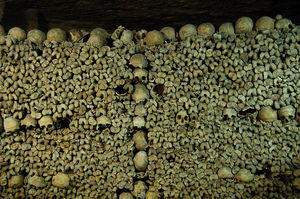Of all the sites in Paris, Europe, and perhaps the world, there are few locations comparable to the Catacombs of Paris.. This “Empire of the Dead” is unlike any tourist destination you are likely to encounter on a Parisian vacation. Located below ground in the Montparnasse section of Paris, visiting the Catacombs is not for the faint-hearted nor the claustrophobic. It can be macabre, even spooky, and people have been known to leave just as quickly as they enter. Yet this place tells a part of the history of Paris and the residents who came before in a way unlikely to be experienced again.
The maze-like tunnels of the Parisian Catacombs contain the bones of Parisians who were first buried largely in communal graves in normal cemeteries on the outskirts of Paris. As Paris expanded with its growing population, however, these cemeteries came to be located in what was the central part of the city. When disease and vermin from these graves threatened this inner-city area, a decision was made to transport the bones of the deceased to these underground tunnels farther out from the city’s center.
The first individuals whose bones ended up in the catacombs came from those buried at the Cimetiere des Innocents; they began to be transported in 1786, and the process continued well into the 19th century. Decomposing bodies from the cemetery were having extremely negative effects in the Les Halles section of Paris, from spreading disease to increasing problems with rats.
The mountains of bones that were dumped at the Catacombs have not been maintained by individuals as is normal with a cemetery. Instead, there are walls of skulls, mounds of tibia bones, and so on, many of which are formed into shapes such as crosses. There is no distinction between pauper and millionaire, saint and sinner, one person and the next. Among the Catacombs’ estimated 6 million nameless souls, at least one famous person is known to have her bones there, Madame de Pompadour (who died in 1764), once the mistress of Louis XV.
Today tourists can explore these stone-mines-turned-underground-cemetery by entering at the Barrière d’Enfer, the former city gate. After descending a narrow stone stairway, and passing through twisted hallways, tourists will approach the l’empire de la mort (empire of death). Those visiting the Catacombs should be prepared for damp conditions and wear appropriate shoes. While the site of so many bones can be unsettling, the Catacombs are well lit, so at least that fear is removed.
There are some closed parts of the Catacombs, which are gated off and inaccessible to tourists. Also not visible to tourists are the cataphiles. These are alternate entrances to the Catacombs that art students have used to make macabre art even as they party in these locations. In addition to their use as a final resting place, the Catacombs played an important role in World War II, when it served as a meeting place for the French Resistance.
Since 1867, the Catacombs have been open to tourists, and that tradition continues to the present day. It is a city of the dead still visited, pondered, and celebrated by the living.

